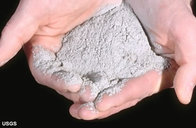The story of helenite begins shortly after the May 18, 1980volcanic eruption of Mount St. Helens that blanketed portions of the northwestern United States with a thin layer of volcanic ash. The eruption was widely described in the media, and millions of people became curious about thevolcano and the impact of the eruption.
Immediately after the eruption, people who lived near the volcano began sharing samples of the ash with curious friends and relatives. People who lived outside of the eruption area began travelling to the impact area to witness the destruction. Many of them carried home a small amount of ash to show to friends and neighbors. The ash quickly became a souvenir.
A few days after the eruption, workers using an acetylene torch while doing salvage work accidentally discovered that the torch could melt the volcanic ash into a green glass. This story was circulated, and experiments determined that a transparent to translucent green glass could be reproduced in a laboratory by heating samples of ash to 2700 degrees Fahrenheit in a high-temperature furnace followed by rapid cooling.
A few people began producing the glass, cutting it into faceted stones, mounting them in jewelry, and selling the items to tourists. Less than one year after the eruption, Dharma Trading Company began using the name “Helenite” in commerce and filed a trademark with the United States Patent and Trademark Office.
Their trademark was filed to reserve the name “Helenite” for their exclusive use in marketing “glass in the nature of cut gems and rough gems made from volcanic ash from Mount St. Helens, for use in making jewelry.



 RSS Feed
RSS Feed


